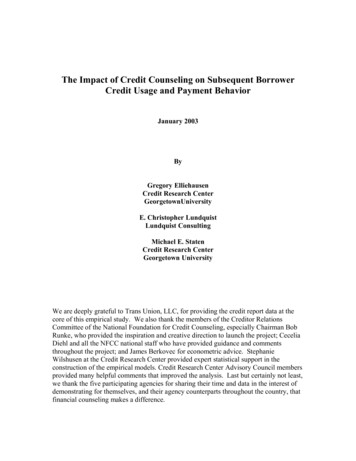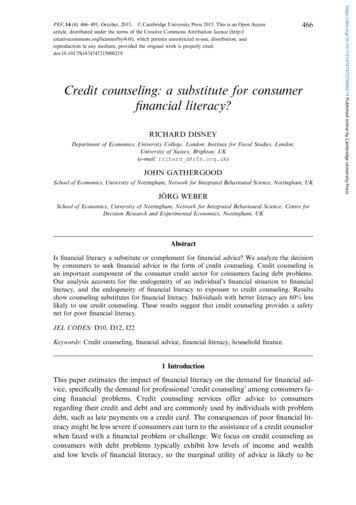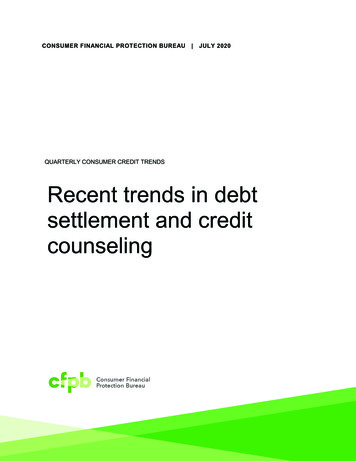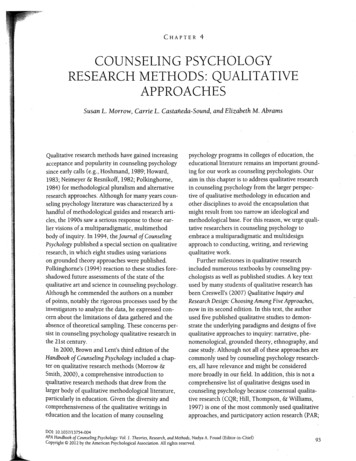
Transcription
The Impact of Credit Counseling on Subsequent BorrowerCredit Usage and Payment BehaviorJanuary 2003ByGregory ElliehausenCredit Research CenterGeorgetownUniversityE. Christopher LundquistLundquist ConsultingMichael E. StatenCredit Research CenterGeorgetown UniversityWe are deeply grateful to Trans Union, LLC, for providing the credit report data at thecore of this empirical study. We also thank the members of the Creditor RelationsCommittee of the National Foundation for Credit Counseling, especially Chairman BobRunke, who provided the inspiration and creative direction to launch the project; CeceliaDiehl and all the NFCC national staff who have provided guidance and commentsthroughout the project; and James Berkovec for econometric advice. StephanieWilshusen at the Credit Research Center provided expert statistical support in theconstruction of the empirical models. Credit Research Center Advisory Council membersprovided many helpful comments that improved the analysis. Last but certainly not least,we thank the five participating agencies for sharing their time and data in the interest ofdemonstrating for themselves, and their agency counterparts throughout the country, thatfinancial counseling makes a difference.
January 2003The Impact of Credit Counseling on Subsequent BorrowerCredit Usage and Payment BehaviorI. INTRODUCTIONEach year, millions of households find themselves overwhelmed with debt and strugglingto maintain their monthly payments. Such debt problems have numerous causes, but theproblems typically trace to events such as job loss, income interruption due to illness ordisability, divorce or separation, and often just poor financial management. In 2001,nearly 1.5 million households resorted to personal bankruptcy as a solution. Between 2.0and 2.5 million people sought advice and other assistance from a credit-counselingagency, sometimes prior to bankruptcy but mostly as an alternative to bankruptcy.1Providing assistance to financially troubled consumers has become a growth industry: asrecently as 1990, the annual number of new clients to credit counseling agencies totaledless than 500,000.We are aware of no empirical studies of financially troubled debtors to determine thelong-term impact of having received financial counseling. There are at least two reasonswhy such evidence would be valuable. First, public policy is increasingly viewingcounseling as important for preventing financial problems in the future. Homeownershipcounseling has long been required by the US Department of Housing and UrbanDevelopment in conjunction with a variety of affordable housing programs. Morerecently, regulatory attempts to reduce predatory lending in mortgage markets haverequired mandatory counseling for subprime borrowers considering “high-cost” mortgageloans. An important provision of the bankruptcy reform legislation working its waythrough the US Congress would require that consumers filing for Chapter 7 bankruptcyfirst complete credit counseling from a court-approved provider. Each of thesecounseling requirements seems to envision either a rehabilitative or preventive role forcredit counseling to avoid future financial problems. However, this is precisely the issueabout which there is a notable lack of evidence. Indeed, in a discussion of the rapidproliferation of financial education programs, the Federal Reserve Board staff recentlynoted “ research measuring the effectiveness of [financial] training has not kept pace.”2A second reason for determining the value of financial counseling is that the market’sability to continue providing these services requires some documentation of the value ofthe service in order for it to be properly priced. A peculiarity of the credit counselingindustry is that the large majority of the revenue generated by counseling agencies12Source: National Foundation for Credit Counseling, Silver Spring, MD.Braunstein and Welch (2002), p. 449.1
derives from a product that is not credit counseling. Very briefly, the bulk of agencyrevenues derive from administering debt repayment plans (Debt Management Plans, orDMPs) for those clients who qualify based on the outcome of an initial counselingsession. These DMPs are attractive debt reduction measures for some consumers becausethey avoid bankruptcy but still gain creditor concessions in the form of reduced interestrates, late fees and minimum payments so long as the consumer stays with the plan.Creditors pay the agency a percentage of the funds recovered under the plan (“fair share”payments). The success or failure of these plans provides an imperfect but readilyobservable metric for evaluating the service provided by the agency.Of course, not all consumers who seek counseling qualify for or need to be placed onDMPs. For many agencies, customers on DMPs represent the minority of clientscounseled. For the remaining majority of counseled clients, the agency output is lesstangible, consisting of education, advice, possibly referrals to social agencies or otherinstitutions to solve specific problems, and generally recommendations for specificchanges in clients’ behavior. Consumers may be charged a small fee for such counseling,but, in keeping with the social-service orientation of most counseling agencies, these feestypically represent a very small part of total agency revenues.3Until the mid-1990s, the fair-share payments from creditors effectively subsidized thecounseling service provided to clients who did not enter repayment plans. However, ascompetition from new entrants to the counseling market has eroded the “fair-share”percentage, agencies that provide counseling to a significant portion of their clientswithout setting them up on DMPs face a financial dilemma.4 Counseling outside of theseplans may well rehabilitate and prevent future financial problems. But, such counselingis resource intensive. Creditors have made it clear that they will not continue to subsidizethe cost of serving non-DMP clients unless the value of such counseling is demonstrated.Thus, the quality and quantity of counseling provided to hundreds of thousands ofborrowers for whom debt repayment plans are not appropriate is in jeopardy.This paper investigates whether financial counseling has a measurable, positive effect onclient credit behavior. We examine the impact of one-on-one counseling delivered byfive non-profit credit counseling agencies to approximately 14,000 clients during a fivemonth period in 1997. Credit bureau data provide objective measures of creditperformance for these clients over a three-year period following the initial counseling3The oldest and largest group of credit counseling agencies are the non-profit members of the NationalFoundation for Credit Counseling. NFCC-member agencies counseled over 800,000 consumers in 2000 in1,300 offices throughout the U.S., frequently under the trademarked name of Consumer Credit CounselingService (CCCS).TM For these agencies, only about one-third of counseled consumers are placed on DMPs.Approximately 72% of agency revenues derive from the fair-share fees paid by creditors out of client DMPpayments. DMP clients (consumers) are often asked to pay an additional monthly fee to the agency for theduration of the repayment plan. Agencies derive about 18% of their total revenues from such clientcontributions. Consequently, nearly 90% of NFCC agency revenues derive from the DMP plan productthat is delivered to just one third of all clients. Source: Bayshore Consulting analysis of 1999 NFCCAgency Operating Reports, as outlined in letter to NFCC national office, April 26, 2000. A copy of theletter is on file with the authors.4Fair-share rates have fallen from historical levels of about 12-15% of funds recovered to 7-8% in recentyears. (Belz 2002).2
session, as well as for a large comparison sample of individuals with risk profiles andgeographic residences similar to the client group in 1997 but who were not identified bythe five agencies as having been counseled.II. METHODOLOGYAny study of the impact of credit counseling on borrowers faces some formidablemethodological hurdles. The issues include the following:1. Standardization of program content: Is the same basic material presented to allclients? Is the content individually tailored (counseling) or generic (classroom orhome study)?2. Identification of a counseled group of sufficient size to be statistically significant3. Identification of a similarly situated non-counseled group as a comparison group4. Ability to track subsequent performance of both groups over time with objectivemeasures that relate to the content of the financial counselingThis section discusses how the current study addresses each of these methodologicalissues.A. Standardization of ContentAt the outset we note a distinction between education and counseling. Credit counselingentails the tailoring of advice to an individual borrower’s specific circumstances. Crediteducation is more generic. It may deal with the same general concepts but withoutexamples fitted to the individual. Applying this terminology, classroom credit educationis often (although not exclusively) generic with few, if any, examples tailored toindividual students. This distinction may be important in terms of the potential for eachto change borrower behavior. However, there has been little or no evaluation of theeffectiveness of either treatment.5 All of the counseling analyzed in this report stemsfrom one-on-one sessions between the borrower (possibly a couple) and a certifiedagency counselor. Consequently, the conclusions apply only to financial educationconducted in a one-on-one setting, and not necessarily to other methods of delivery.65In contrast to the lack of research on the effectiveness of credit counseling, a small body of empiricalwork has examined the effectiveness of home ownership education and counseling (HEC). HEC hasreceived far more policy attention because it is believed to be a valuable tool for increasing stablehomeownership among traditionally underserved segments of the population. The scope of HEC is broaderthan credit counseling since it can touch on a variety of issues related to a home purchase, mortgageacquisition and post-purchase home maintenance. However, the methodological challenges todocumenting the impact of HEC are quite similar to those faced by a study of credit counseling. Forexcellent surveys of both past research and methodological issues see Mallach (2000) and Quercia andWachter (1996). For a recent study that found positive effects of pre-purchase HEC in terms of reducingmortgage delinquencies see Hirad and Zorn (2001).6We raise this distinction because the call for mandatory pre-bankruptcy counseling in the pendingbankruptcy reform bill appears to require classroom-style education. However useful that may prove foralerting debtors to the existence of non-bankruptcy options, we simply do not have any evidence as to thevalue of such education for preventing a recurrence of financial problems in the future.3
The counseling assessed in this study was administered by five NFCC agencies betweenApril and August of 1997. All clients received a 60 – 90 minute session with a certifiedcredit counselor. Each session provides an opportunity to analyze the family orindividual’s financial situation in a give-and-take forum that raises and resolves questionsrelated to debt, income and payment issues. The counseling session normally includeskey components: a discussion of the financial goals of the family; financial strengths andweaknesses; and a comprehensive, detailed review of the family’s budget and spendingpatterns. Assets, liabilities, income and debts are reviewed to uncover resources that canhelp the client regain financial control. Options are discussed. The root of the problemthat has led the client family to this point is assessed and, as appropriate, referrals toappropriate organizations in the community are made – often to a social service agency toaddress issues that may be contributing to family instability (e.g., addiction). Finally, awritten action plan is developed to identify the appropriate next steps. Additionalcounseling sessions may be needed. Additional education programs and support groupsmay be offered.What advice do counselors typically offer to clients in counseling sessions? Althougheach session is customized to the needs of the individual family, the following themessurface repeatedly: Ways to increase income, i.e., increasing exemptions, taking on part-time jobs,decreasing unnecessary payroll deductions, selling items the family can dowithout, etc. Decrease household spending, i.e., reducing utility costs, bringing lunch to work,etc. Be clear about priorities and pay high priority debt first Keep fewer lines of credit open Reduce debt levels Pay higher amounts on accounts that have larger balances combined with higherinterest rates Make consistent and timely monthly payments Adjust or reformat existing accounts through refinancing; seek lower financingoptions Work with creditors directly to get payments/interest reduced Resolve credit reporting inaccuracies Don’t apply for credit just to see if you can get accepted Avoid accumulating unnecessary inquiries on the credit report Review legal rights and options available Save for upcoming events: mortgage downpayment, marriage, Christmas, etc.B. Identification of Counseled IndividualsThe NFCC obtained the cooperation of five member agencies for this study.Participating agencies included CCCS of Atlanta, CCC Farmington Hills (suburbanDetroit), CCCS of San Francisco, CCCS Southwest (Phoenix) and CCCS of Dallas. Eachof these agencies operates multiple offices in their geographic market area (in some casesoffices are located in more than one state). Each agency provided data on all clients for4
whom an initial counseling session was conducted during 1997. Since this paper focuseson the impact of counseling on those consumers who do not establish DMPs, all sessionsthat resulted in DMPs were removed from the database, leaving a total of 55,527 clientsfor analysis.7 For each client, the agencies provided identification information (name,address and social security number). Table 1 below provides details of the sample byagency.Two issues that could affect the interpretation of the results should be noted. First, not allof the counseling sessions were conducted face-to-face. Telephone counseling emergedin the mid-1990s and has become an increasingly popular alternative to in-personmeetings. Consumers may favor telephone counseling because of the convenience interms of reduced time and travel costs. Some agencies may favor it from an operationalstandpoint because a given volume of clients can be served at lower cost, relative to thebrick-and-mortar capacity required for in-person counseling. Agencies have also foundthat some consumers are more comfortable/less embarrassed about discussing theirfinancial affairs if they can do so from a distance. Telephone counseling has boosteddemand because it has overcome the initial reluctance of some consumers to givecounseling a try.We raise this point because the question of whether telephone counseling is as effectiveas face-to-face counseling is the subject of ongoing debate within the industry.Unfortunately, our results do not contribute to this debate. Our sample contains both inperson and telephone-counseled clients but does not distinguish one from the other. Onlyaggregate statistics on the percent of clients counseled by telephone are available. Table1 displays the percentage of clients who were counseled in-person for each agency during1997. If there is a difference in effectiveness of the two delivery methods, our resultsreflect a blend of the two.A second point concerns the outcomes of the initial sessions. Clients who do not end upon DMPs are not a homogeneous group. At the end of an initial counseling session witha new client, the counselor typically makes an evaluation of the client’s situation. NFCCagencies have developed several descriptive categories that are used across memberagencies to describe the counseling outcome. In some cases the counselor designates theoutcome as “client could handle,” meaning that the client has sufficient income to servicethe debt without creditor concessions or other assistance. In other cases the client isrecommended for a debt management plan but declines the offer. In still other cases theclient is “referred for legal assistance,” (e.g., bankruptcy or other legal advice) becausespecific issues must be addressed before a serious repayment effort is viable.Based on discussions with the agencies, we have determined that the codes for these andother outcomes are applied inconsistently across agencies. Consequently, they areunreliable indicators of whether clients may be more or less likely to demonstrate postcounseling improvement in their debt levels and payment performance. While allagencies have these codes on their database, we did not request their inclusion in the filesextracted for this project. Agencies were asked to include in their sample all clients with7Analysis of the post-counseling behavior of DMP clients will be conducted in a separate study.5
an initial interview during the sampling period, except for those that were placed on debtmanagement plans.However, one agency apparently did make use of the outcome codes and excluded clientswho were tagged as “referred for legal assistance” (RLA) or “client could handle” (CCH)prior to providing us with their data. The dropped cases represented about 23 percent ofthe initial interviews conducted by this agency in 1997 (8.5 percent RLA; 14.8 percentCCH). Notwithstanding the inconsistency in applying codes across agencies, thedropped cases seem to be a blend of the best and worst situated clients with respect tofinancial situation. Consequently, it is not possible to determine the direction in whichthe loss of these cases might bias the outcome observed in the remainder of that agency’ssample.Table 1. Client Characteristics, 1997Number ofOffices151997 Clients15,684PercentCounseled inPerson87.5CCCS Farmington Hills, MI3610,212100.0CCCS of San Francisco127,28948.1CCCS Southwest, Phoenix1613,90074.5CCCS of Dallas328,44285.6Total11155,52781.1AgencyCCCS of AtlantaC. What Behavior Should Be Measured?Counseling has at least two objectives. Since clients almost always seek counselingassistance because they sense they are in financial trouble, one of the goals is to provideadvice and assistance to reduce or cure the immediate problem and lower debt burden.But, the description above of the advice offered during counseling sessions makes clearthat a second and longer-term goal is to improve borrower awareness, planning andbudgeting skills to prevent overextension in the future. An evaluation of progresstoward both goals requires some objective measures of credit usage and paymentperformance over an extended period.Credit report information provides such a measure. For the NFCC project Trans Union(TU) provided credit bureau snapshots for individuals in both the counseled andcomparison group samples at multiple points in time and under appropriateconfidentiality and disclosure agreements. TU used the identification information forcounseled clients that was supplied by the participating agencies and appended thatindividual’s credit file data. Appended data included the full set of variables describingthe various credit data fields on the credit report, plus several types of risk scores. TU6
depersonalized (i.e., removed the personal identification fields) the dataset beforeproviding it to the research team for analysis.The analysis below examines the credit bureau profile for each member of the counseledand comparison groups at two points in time, June 1997 and June 2000.8 The objective isto determine whether the counseled group’s credit performance (defined in a variety ofways) improves over the three year period following the initial counseling session,relative to the comparison group.Ideally, for this analysis we would see the clients’ true credit profile at the moment theyenter the first counseling session. The clients’ credit reports provide a useful butimperfect substitute since there is always lag time between a credit event and the time itis first reflected on the credit report. For most events the lag is 30-60 days. Because wehave access to a single credit bureau snapshot in June 1997, we selected into our analysisall clients of the five participating agencies for whom the initial counseling session tookplace between April 1st and August 31st in 1997 (60 days either side of the June bureausnapshot).9 Additional criteria for retention of each client in the sample included (1)ability to match client with a credit report in both June 1997 and June 2000 and (2) theclient had an Empirica risk score present in the file for both years.10 The final sample ofcounseled borrowers that met these criteria included 14,559 individuals.D. Identification of Comparison GroupA key component of the analysis was the selection of a comparison group of similarlysituated borrowers who did not experience credit counseling during 1997. Since thecounseled group came from five distinct agencies around the country (vs. a randomsample of all clients nationally), geographic location was one of the two criteria forselection into the comparison group. The other criterion was that the borrower has acredit profile similar to members of the counseled group. Of course, there are literallyhundreds of variables in a credit report, complicating the task of deriving a singlemeasure that encompasses all dimensions of the borrower’s credit profile. Fortunately,credit bureau risk scores are constructed to consolidate the predictive value of theindividual credit report variables into a single index that measures the relative likelihoodof future payment difficulties. The Empirica score contained in the Trans Union creditfiles is built to predict the likelihood of varying degrees of future delinquencies, non8Currently only the June 1997 and June 2000 bureau snapshots were available for analysis. However,Trans Union has committed to providing archived snapshots from intermediate quarters, plus snapshotsfrom quarters prior to the date of counseling. Additional hypotheses about the impact of counseling and thedynamics of the counseled clients’ financial situation will be explored as those data become available.9Note that this includes a group of counseled clients for whom the snapshot precedes their counselingsession. The five month sequence of counseled clients, each with a June 1997 bureau snapshot, allows usto explore the hypothesis that the decision to seek counseling may reveal information about the borrower’scircumstances that is not yet evident in the credit report. This idea will be developed more fully in thefollowing sections.10The Empirica score is Trans Union’s proprietary credit bureau score. Empirica scores are comparable toFICO scores.7
bankruptcy charge-offs and bankruptcies. Empirica scores are widely used by creditorsto evaluate borrower risk. Consequently, the Empirica score provides a comprehensiveand objective measure of creditworthiness for purposes of this analysis.To summarize, borrowers were selected into the comparison group if (1) they lived in thesame geographic area as the counseled group and (2) had the same calculated likelihoodof future delinquency as the counseled group at the time the initial counseling occurred.These criteria were applied to a large random sample of over 1 million Trans Unioncredit files. The final comparison group consisted of borrowers who met the followingspecific criteria: (1) each resided in the 3-digit zip code ranges represented in thecounseled client sample, (2) the borrower did not appear on the list of clients counseledby the five participating agencies during 1997, (3) each had both a credit report and anEmpirica score for June 1997 and June 2000, and (4) each borrower’s Empirica scorevalue fell within the same range as observed in the counseled client sample. Theresulting sample that served as the comparison group for subsequent analysis contained98,322 records randomly selected from the pool of individuals who met these criteria.The majority of these individuals had Empirica scores that fell toward the upper end ofthe range for the counseled sample.One final point is important when comparing the performance of the counseled vs. noncounseled groups below. Just because the comparison group members do not appear onthe list of individuals counseled at the five participating agencies in 1997 does not ensurethat they were never counseled. Some comparison group members could have soughtcounseling from these agencies in either earlier or later years. Some could have receivedcounseling from one of these agencies’ competitors at any time, either in-person or overthe phone. Since the incidence of financial counseling is not reported to a credit bureau,there is no way to use credit report data to screen for counseling. For our purposes, thepotential for some of the comparison group to have received counseling at a differenttime or from a different agency raises the bar for demonstrating a positive impact ofcounseling. In other words, if counseling actually has a positive effect, and if somemembers of the comparison group received counseling, then the overall performance ofthe comparison group will be elevated (to some degree). The impact of counselingwould need to be strong to demonstrate statistically significant improvement in theperformance of the counseled group relative to a comparison group that may containsome counseled borrowers.D. Data PreparationThe analysis described in the following sections utilizes a variety of credit bureauattributes as either independent or dependent variables. Of the 112,881 borrowers in thecounseled and comparison samples, 108,670 (96.3%) had complete information in both1997 and 2000 for the credit bureau variables used for analysis.Although credit bureau files provide a very detailed picture of each borrower’s past andcurrent credit usage, the bureau files contain virtually no demographic data on borrowers.A borrower’s income is especially important for analyzing credit use and paymentbehavior. Because most debts are repaid in installments from current income, the8
borrower’s income largely determines the amount of debt that a consumer can serviceand the magnitude of the debt burden on the monthly budget.The credit bureau files do contain information on where the borrower lives. Filesprovided by Trans Union for this study included geo-coded data that translated to variousCensus bureau definitions of geographic areas. These, in turn, were used to mergeCensus average statistics for those specific areas as a proxy for the missing information atthe individual borrower level. A Census block group is the smallest geographic unit forwhich the census tabulates and publishes data.11 Census block group numbers wereprovided for about three-fifths of the borrowers in the counseled sample. Medianhousehold income and median age for the block group were matched to the credit bureaudata for these borrowers. The distance between the borrower’s residence and the nearestcounseling office was also calculated for these borrowers. Borrowers with no blockgroup information were excluded for this analysis.12As mentioned previously, the comparison sample contained many more borrowers thanthe counseled sample, especially at higher levels of Empirica scores. A random sampleof borrowers from the comparison group was selected for this study. The comparisongroup sample was stratified by five initial (1997) Empirica score categories that spannedthe range of scores observed in the counseled group, with approximately equal numbersof borrowers in each stratum. An appendix provides summary statistics on counseled andcomparison-group borrowers in each of the five initial Empirica group categories.To reduce the influence of extreme outliers (likely reflecting extraordinary circumstancesor data errors) on the results, a few borrowers with no reported debts were excluded fromthe counseled group. Also a few borrowers with unusually low or high debts (the bottomand the top percentile of the distributions with respect to total debt and consumer debt)were excluded. These exclusions left a range in total debt from 267 to 306,017 and arange in consumer debt from 42 to 298,379. The same exclusions were used to selectthe stratified random sample of approximately equal size to serve as the comparisongroup. The final sample used for analysis consisted of 11,487 borrowers, 5,973 in thecounseled group and 5,514 in the comparison group.III. THE EMPIRICAL MODELRegression analysis was used to detect whether receipt of credit counseling changedborrowers’ subsequent borrowing and payment behavior. The regression model providesa statistical estimate of the effect of counseling on behavior holding constant otherobservable factors that may influence the performance of both counseled andcomparison-group borrowers over the evaluation period.11There were 229,192 block groups for the 1990 Census (Bureau of the Census 1994). The average blockgroup contains a little more than 1,000 persons.12Credit use and payment statistics for borrowers with and without the Census block numbers were similar.Analyses that did not include geographic variables at the block group level (i.e., with the full sample of108,670 borrowers) did not produce results that differed from those reported below.9
The change in behavior over a three-year evaluation period from June 1997 and June2000 is the dependent variable in the regression analysis. We considered severaldifferent measures of behavior: (1) summary measures represented by credit bureauscores, (2) measures of credit use such as the amount of debt
3 The oldest and largest group of credit counseling agencies are the non-profit members of the National Foundation for Credit Counseling. NFCC-member agencies counseled over 800,000 consumers in 2000 in 1,300 offices throughout the U.S., frequently under the trademarked name of Consumer Credit Counseling Service (CCCS).










